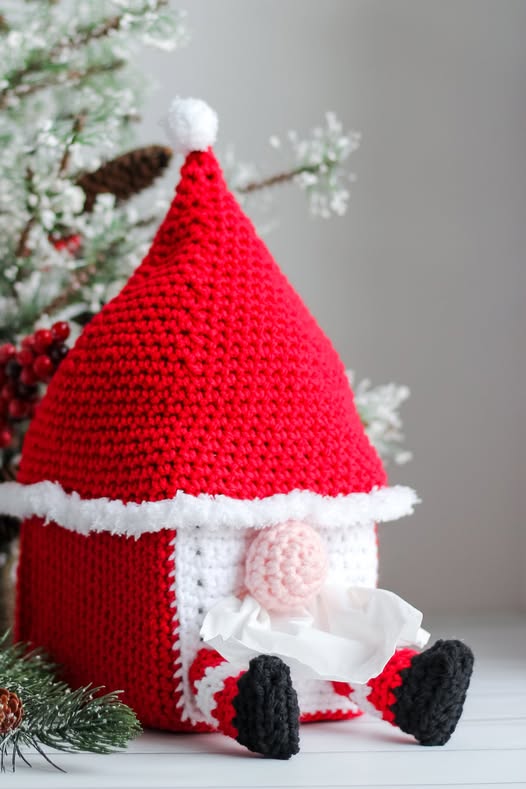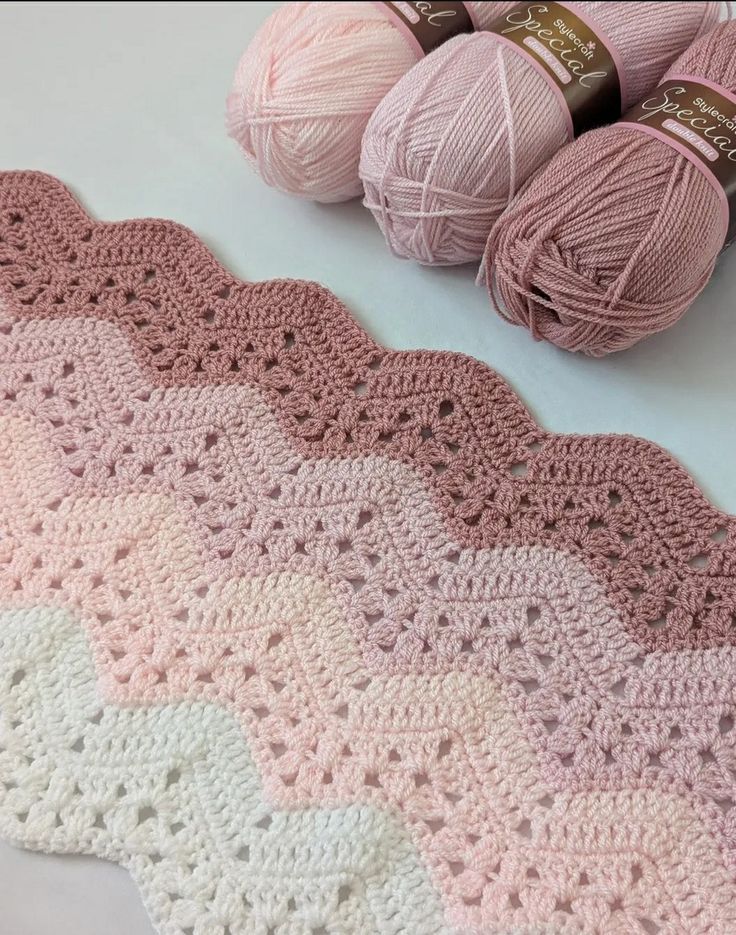

The Mixed Ripple Stitch Pattern is a versatile and visually striking crochet design that adds texture, movement, and charm to any project.
This pattern is ideal for blankets, scarves, shawls, and even home décor items, offering a rhythmic wave-like appearance that is both eye-catching and elegant.
Using the Mixed Ripple Stitch Pattern, crafters can experiment with color changes, stitch combinations, and row variations to create a piece that is uniquely theirs.

The beauty of this pattern lies not only in its aesthetic appeal but also in the way it combines different stitches to produce depth, dimension, and a flowing sense of motion throughout the fabric.
One of the main advantages of the Mixed Ripple Stitch Pattern is its adaptability. Whether you are a beginner looking to try something new or an experienced crocheter seeking a more complex design, this pattern can be adjusted to suit your skill level. Its repetitive wave-like sequence provides structure, while the combination of stitches allows for creative freedom. By incorporating multiple colors or varying yarn thickness, you can make your ripple pattern bold and vibrant or soft and understated. The Mixed Ripple Stitch Pattern is perfect for expressing creativity while maintaining an organized and cohesive design.
Another reason this pattern is beloved by crochet enthusiasts is its timeless appeal. Ripples and waves have long been used in textile art to convey fluidity, movement, and natural beauty. Using the Mixed Ripple Stitch Pattern, you can create pieces that feel dynamic and alive, whether you’re making a cozy blanket for your home or a fashionable accessory to wear. This stitch pattern also allows for a balance between texture and flexibility, making it practical as well as beautiful.
Selecting the right yarn is crucial when working with the Mixed Ripple Stitch Pattern. Soft, high-quality yarns such as cotton, acrylic, or wool blends are ideal because they provide both structure and flexibility. Lighter yarns produce a delicate, drapey ripple, while thicker yarns create a bold, textured wave. Choosing yarn that feels comfortable to touch is also important, especially for wearable items or blankets.
Color selection is another key factor in creating a visually appealing Mixed Ripple Stitch Pattern. By alternating colors along the peaks and valleys of the ripple, you can enhance the three-dimensional effect of the stitch. Gradient yarns or ombré colorways work exceptionally well, as they naturally accentuate the flow and movement inherent to this pattern. Beginners may prefer to use two or three complementary colors, while experienced crocheters can experiment with multiple hues to create a vibrant mosaic effect.
It’s also important to consider contrast. High-contrast colors help highlight the ripple effect, while subtle tones produce a more gentle, understated wave. You can plan your color scheme by laying out your yarn choices before starting your project to ensure the combination achieves the desired effect.
Texture can further enhance the Mixed Ripple Stitch Pattern. Pairing smooth yarns with slightly textured or boucle yarns can create an interesting visual and tactile experience. You can also experiment with different stitch heights to exaggerate the ripple effect, making the peaks and valleys more pronounced.
Another tip is to consider the final use of your project. For blankets and throws, soft and cozy yarns with a gentle drape are ideal. For home décor items like cushion covers or table runners, sturdier yarns with good stitch definition may be more appropriate. The Mixed Ripple Stitch Pattern can be adapted to suit a wide variety of materials and purposes.
Finally, always make a small swatch before committing to a full project. This allows you to test yarn combinations, tension, and the overall ripple effect. Adjusting the stitch count or hook size during this stage ensures your finished project will look polished and professional.
To begin the Mixed Ripple Stitch Pattern, start with a foundation chain that is a multiple of the stitch pattern plus any additional chains required for turning. The key to achieving a consistent ripple is maintaining even tension and counting stitches carefully. This pattern often involves combining single, double, and treble crochet stitches to create peaks and valleys.
Work the first row according to the instructions, paying attention to where increases and decreases occur. These variations in stitch height create the signature ripple effect. Using a stitch marker can help track your progress and ensure your peaks and valleys align correctly.
In subsequent rows, continue the established pattern, alternating stitches as indicated. Color changes can be introduced at the end of a row for a clean transition. Carrying the yarn along the back or cutting and weaving in ends are both options depending on your preference. For the Mixed Ripple Stitch Pattern, neat color changes enhance the visual flow of the waves.
Press or block your finished piece if necessary. Blocking can open up the ripple, making the waves more pronounced and giving your project a professional finish. Lightweight projects such as shawls may benefit from gentle steam blocking, while heavier blankets may require wet blocking for better shape retention.
Adjusting the width and length of your project is straightforward with this pattern. Simply increase or decrease the number of pattern repeats to suit your desired dimensions. The Mixed Ripple Stitch Pattern is scalable, making it ideal for projects of any size, from small scarves to large afghan blankets.
Finally, add finishing touches such as edging or fringe if desired. A simple border can frame the ripples, while a decorative fringe can complement the wave-like design. These details enhance the beauty of your work and give the finished item a polished appearance.
The Mixed Ripple Stitch Pattern is perfect for a wide range of projects. Blankets and throws are the most popular applications, as the wave pattern provides both warmth and visual appeal. Using multiple colors, you can create a stunning, eye-catching blanket that becomes the centerpiece of a room.
Scarves and shawls benefit greatly from this pattern as well. The ripple stitch adds texture and movement, giving the fabric a flowing, elegant look. Lightweight yarns allow the ripples to drape beautifully, while thicker yarns make a cozy, bold accessory.
Home décor items such as cushion covers, table runners, and wall hangings also work well with the Mixed Ripple Stitch Pattern. The undulating waves provide a dynamic element that draws attention, while the textured stitches add tactile interest. You can match colors to your room’s theme for a coordinated, stylish look.
The pattern is also ideal for gifting. Handmade items like ripple stitch scarves or blankets are thoughtful, personalized presents that showcase your crochet skills. Experimenting with color combinations and textures allows you to tailor each gift to the recipient’s preferences.
This stitch pattern is versatile enough to be used for small accessories, like headbands, pot holders, or even tote bags. The ripple effect adds charm and sophistication to even the smallest projects, making them stand out.
For quilters and mixed-media artists, the Mixed Ripple Stitch Pattern can be incorporated into larger fabric projects. Combining crochet ripples with sewn fabric panels or appliqué adds a layered, multidimensional effect that is visually captivating.
Consistency is key when working with the Mixed Ripple Stitch Pattern. Make sure your tension is even throughout the project to maintain smooth, uniform ripples. Uneven tension can distort the wave effect and create irregular peaks and valleys.
Always count stitches carefully, especially at points where increases or decreases are required. Missing or adding stitches can disrupt the ripple, so take your time and double-check your work. Using stitch markers at key points can be very helpful.
Choosing appropriate hook sizes is also important. A hook that is too small may make your ripples stiff, while a hook that is too large can create loose, floppy waves. Test your hook size on a swatch before starting the full project.
When introducing color changes, plan ahead to minimize yarn ends and weaving. Carrying yarn along the back or using tapestry techniques ensures smooth transitions and a clean finish. The Mixed Ripple Stitch Pattern benefits greatly from thoughtful color planning.
Blocking your finished project can significantly enhance the ripple effect. Use gentle steam or wet blocking depending on your yarn type to open up the waves and improve drape. Proper finishing techniques elevate the overall look and feel of your piece.
Finally, practice patience and enjoy the process. The Mixed Ripple Stitch Pattern is as much about the creative journey as the finished item. Experimenting with stitches, colors, and textures allows you to make each project uniquely your own.
1. What is the Mixed Ripple Stitch Pattern best used for?
It is ideal for blankets, scarves, shawls, home décor items, and small accessories like bags or headbands.
2. Can beginners try this pattern?
Yes, it is beginner-friendly with basic stitch knowledge, though patience and attention to stitch counts are necessary.
3. What yarn works best for this pattern?
Cotton, acrylic, and wool blends are ideal for their flexibility, durability, and stitch definition.
4. How do I maintain the ripple shape?
Consistent tension, careful counting, and blocking finished pieces help maintain even peaks and valleys.
5. Can I use multiple colors?
Absolutely. Alternating colors enhances the ripple effect and creates visually striking designs.
6. How long does it take to complete a project using this pattern?
Time varies depending on project size and complexity, ranging from a few hours for small items to several days for blankets.
The Mixed Ripple Stitch Pattern is a beautiful and versatile crochet technique that brings texture, movement, and style to any project.
By choosing the right yarn, colors, and hook size, and following careful stitch patterns, you can create pieces that are visually stunning and uniquely your own.
From blankets and scarves to home décor and gifts, this pattern offers endless possibilities. Embrace the creative journey, experiment with colors and textures, and share your finished projects.